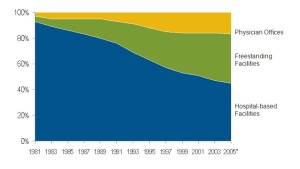Survival of the fittest!
It is very well know that in today’s healthcare business, cash flow is the life blood of any business, specifically in the healthcare industry.
The healthcare industry has become much more competitive over the years. Hospitals proclaiming that they have a state of the art cardiology center, with nurses that put the patient first. I am sure that hospitals across the country put their patients first, it’s just that they do it better, the ad claims.
We see the messages on billboards lining the streets, on TV. from shows like Big Medicine and such. Walk thru a mall and see the ad’s from doctors who are specialist in plastic surgery, weight control, and various other procedures.
One would ask why a doctor, hospital does, emergency service need to advertise, don’t they receive their patients from word of mouth, one doctor recommending another?
One would think so, but the game has changed for ever. In the near future the family doctor will no longer be. We will all be seeing a“specialist” for what ill’s us. You may ask yourself “so what’s wrong with that?” well there is nothing wrong, but if you work in the healthcare industry and run a practice, hospital, emergency care center and such, well you need to make sure that your business has steady cash flow and has a competitive edge, and in today’s world the edge is CASH!
Medicaid and Medicare set the stage for what will be paid on claims. As we know, HMO’s and PPO’s and other insurers follow suit and try to under pay claims as well. You the healthcare provider are providing services on a daily basis and do not receive payment on the claim for 45 to 90 plus days, and that is if it is coded correctly.
The point that I am trying to make is that there is much more competition for each dollar that is out there and a lot of energy is spent to collect that dollar. Separating yourself from you competition is important. Having the steady cash flow for working capital to grow is imperative!
The number one key factor in a provider’s fiscal downfall, or lack of growth, is the lack of working capital. A solution to prevent this lies in the provider’s accounts receivable, an asset often wasting away accumulating dust on the balance sheet that becomes lost revenue due to the time value of money.
Many “C-Suite” healthcare executives are choosing medical accounts receivable (MAR) funding as an important tool in their business financing strategies. MAR funding’s flexibility and immediate cash infusion reduces their dependency on debt-incurring bank loans and lines of credit as their sole forms of financing. It provides a predictable and steady cash stream and the amount of medical accounts receivable funding is not limited by a bank’s often under-valued assessment of the provider’s assets
Bank credit lines are often insufficient to meet a provider’s working capital needs and monthly cash flow plans, especially when a conventional bank determines a line based on a significantly “under-valued” valuation of the provider’s assets. Additionally, the bank may be quick to disqualify that collateral once the aging reaches 90 days. This often happens because most conventional banks do not have the deep understanding and working knowledge of the healthcare business, its industry specific regulatory requirements and cash flow challenges.
I challenge you to take a look and see if your business can survive?
How “fit” is your business?
Who are your competitors?
Do you have cash on hand to handle the ups and downs or to expand your business, to be competitive?
Editor’s Note: James Hill is the author of this article and, Vice President at Choice Med Consulting. You can check out his profile on linkedin
